 |
 |
|
 |
Work zone safety campaign hits billboards, airwaves |
 |
 |
 |
|
In 2002, 18 people died in Minnesota work zone crashes—an
increase of 80 percent from 2001. Mn/DOT again urges motorists to stay
alert and obey work zone speed limits.
|
Keep your eyes peeled for Mn/DOT’s work zone safety posters coming soon to
billboards and buses near you.
While you’re at it—keep your ears tuned for the work zone radio public service
announcements reminding drivers to do their part so everyone gets home safely
at night.
Mn/DOT is focused on delivering the work zone safety message to motorists statewide
in as many formats as possible, said Mary Meinert, Mn/DOT’s work zone safety
awareness coordinator. The bottom line is: work zone crashes can be avoided.
"Budgets are tight, but there is a lot of road construction planned again
this summer," Meinert said. "Safety in work zones is of great concern
and the investment in educating the public is worth every penny. We don’t want
any more names added to our worker’s memorial."
In 2002, 18 people died in Minnesota work zone crashes—an increase of 80 percent
from 2001, according to Jon Jackels, pavement marking, work zone and product
evaluation engineer, Office of Traffic, Security and Operations.
"Safety in work zones is Mn/DOT’s top priority and everyone is responsible
for their part, Jackels said. "My best advice: stay alert and obey the
speed limit in work zones."
|
back

|
 |
Hiawatha light rail transit project nears three-quarters’ completion |
 |
 |
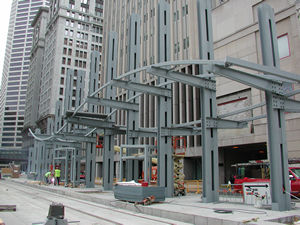 |
The Nicollet Mall light rail transition station is now under construction.
An artist's rendering of what the completed station will look like is
shown below. Photo courtesy of the Hiawatha Project Office
|
Two years since breaking ground, the Hiawatha light rail transit line is now
72 percent complete and continues to be on time and on budget.
While motorists will notice fewer impacts to traffic this spring, there will
be no shortage of visible progress along the 11.6-mile corridor.
Construction crews returned to downtown Minneapolis in early April to lay track
near the Hubert H. Humphrey Metrodome. All track work will be complete in downtown
Minneapolis by early July. Crews also have begun installing poles that carry
overhead electrical wires that power the trains.
Also in April, construction began in the Bloomington area, where passenger
service will begin in late 2004. The contractor will progress in stages down
the median of 34th Avenue with civil construction and track installation taking
the entire season. North-south traffic will be maintained at all times along
34th Avenue during this work.
Though parts of the Hiawatha Line are nearly complete, much work remains for
the next two construction seasons.
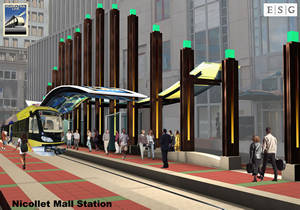 |
Artist's rendering of the Nicollet Mall Station. Courtesy of the
Hiawatha Project Office
|
"We have a lot of work ahead of us," said John Caroon, Mn/DOT design/build
project manager for the Hiawatha LRT Project. "But with two years under our
belt we are confident that we are building an outstanding line that will be
ready for passengers next April."
For details on upcoming closures related to light-rail construction, visit
the Hiawatha Project Web site at http://www.dot.state.mn.us/metro/lrt/
or call the 24-hour hotline at 651/284-0502.
By Josh Collins, Community Outreach Specialist, Hiawatha Project
Office
|
back

|
 |
‘Bridge breaking’ signals start of project to build new Hwy 10 span connecting
Fargo, Moorhead |
 |
 |
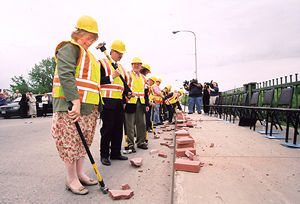 |
Federal, state and local officials smashed cinderblocks to symbolize
removal of the old Main Avenue (Hwy 10) bridge that connects Fargo and
Moorhead and dedication ceremonies held May 27. Lt. Gov./ Commissioner
Molnau is in the foreground. Photo by David Gonzalez
|
Protected by hardhats and goggles, federal, state and city officials wielded
sledgehammers to smash cinderblocks representing the current Hwy 10 Main Avenue
Bridge between Moorhead and Fargo that will be replaced by a new bridge in 2004.
The "bridge breaking" ceremony was held May 27 in the middle of the
existing bridge, halfway between the states of Minnesota and North Dakota.
Participants hailed the new bridge that will provide an improved connection
between the two cities. The new structure, they said, will enhance safety, promote
economic growth and provide a crossing less likely to be damaged by the flood-prone
Red River of the North.
The bridge’s design also includes public plazas at each end of the bridge and
a mid-span plaza intended to attract bicyclists and pedestrians to gather, relax
and enjoy a panoramic view of the river valley. The plaza will be large enough
to host small events and could include amenities such as historical information
about the Red River, the cities and the old bridge.
The bridge will have four 12-foot traffic lanes and a pedestrian walkway. The
new structure will be substantially higher than the old bridge, reducing potential
damage from floodwaters or collected debris. The bridge’s height will also allow
running Third Street in Moorhead under the bridge and eliminating the street’s
intersection with Main Avenue, the most dangerous intersection in Detroit Lakes/District
4.
Construction of the new, $14 million Main Avenue Bridge will be completed in
2005. The bridge is a joint effort by the North Dakota DOT and Mn/DOT as well
as the cities of Fargo and Moorhead. Mn/DOT is the lead agency on the project;
Tom Swenson, District 4, serves as project engineer.
Speakers at the dedication ceremony included Lt. Gov./Commissioner Carol Molnau;
Pamela Gulleson representing U.S. Sen. Byron Dorgan of North Dakota; U.S. Rep.
Collin Peterson of Minnesota; North Dakota Gov. John Hoeven; Mayor Bruce Furness
of Fargo and Mayor Mark Voxland of Moorhead.
Molnau said since the old bridge was built in 1936, the Fargo-Moorhead area
has more than tripled in population and grown in regional significance. The
new bridge, she said, is designed to accommodate growth and other changes in
the region.
"The partnership has resulted in a project that is not only an urban centerpiece,
but is also a bridge that will enhance mobility, improve flood control and promote
economic development," she said.
In his remarks, Hoeven said the new bridge will create an economic and cultural
span that will bind not only Fargo and Moorhead but the two states as well.
"Much like the International Peace Garden in Dunseith reminds of our friendship
with our Canadian neighbors, this new bridge will serve every day as a reminder
that two communities and two states can work together for the common good of
their citizens," he said. "May this bridge stand for decades to come
as a testament to that friendship."
By Craig Wilkins
|
back

|
 |
Mn/DOT riders pedal their support for Bike to Work Week |
 |
 |
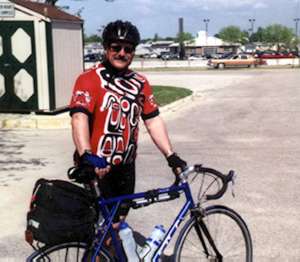 |
Craig Falkum arrives at the Rochester/ District 6 headquarters after
his 43-mile bike commute from Wabasha. Photo by Brian Jergenson.
|
May 15 found many Minnesotans commuting in ways other than driving alone in
their cars.
The day was part of National Bike to Work Week, an effort backed by the League
of American Bicyclists to persuade commuters to find alternatives to driving
to work or school for their benefits to the environment and the individual’s
wellness.
From her home in St. Paul’s Highland Park neighborhood, Sue Stein, Office of
Communications, joined a group of bicyclists for a ride to the Capitol. Other
groups of bikers arrived from starting points on St. Paul’s Summit Avenue, the
Gateway Bike Trail, St. Paul’s Battle Creek neighborhood, Roseville and West
St. Paul.
In Roseville, Marv Hondl, an engineering specialist, arrived by bike after
a 17-mile ride from his home in New Hope, the same trip he makes three or four
days each week. He was joined by Jim Nelson, who rode his bike 13 miles from
south Minneapolis.
Nelson rides most days as long as the streets and roads are not snowy or icy.
Riding to work, he said, gets him energized for the day while the ride home
provides release from the workday’s stress.
"I ride for fitness and to do my share for the environment," he said.
"Mainly, I really enjoy it."
Hondl, who has been riding for about 20 years, said he has worn out a couple
of bikes during his years of commuting.
At about the same time Nelson and Hondl arrived at the Waters Edge building,
Craig Falkum rode into the parking lot of the Rochester District office after
a 43-mile trip from his home in Wabasha.
Unlike Hondl and Nelson, Falkum is a not a regular bike commuter. He decided
to make the long, mainly uphill ride as a personal challenge. He had made the
ride once before but downhill—from Rochester to Wabasha.
Falkum, the district structures engineer, planned to ride his bike and then
carry it home in a new car. His car wasn’t ready, however, so Falkum rode the
43 miles back to Wabasha. He then rode around town for a while to clock 100
miles and meet the requirements for a century ride.
Falkum is an avid biker who plans to pedal his lightweight road bike in the
annual Ride Across Iowa this July.
He chose to commute on May 15 to demonstrate his support for biking and to
achieve his goal of biking to work—uphill.
In a news release announcing Bike to Work Day, Lt. Gov./Commissioner Carol
Molnau encouraged commuters to try biking, walking or using transit.
"We need to remember that roads can be used by bikes as well as by other
vehicles," she said. "Bicyclists and drivers can share the road and
reduce congestion."
By Craig Wilkins
Molnau joins employees for annual Capitol complex
walk
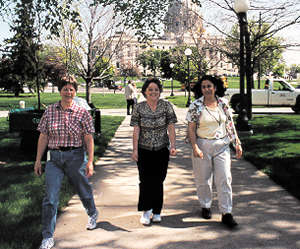
Shortly before noon on May 15, Lt. Gov./Commissioner Carol Molnau joined
Mn/DOT employees for a walk around the Capitol complex organized by
Steve Zvonar, Human Resources, to promote the benefits of walking.
The Office of Land Management earned the award for having the most
people—23—participate in the event. Most of the participants made several
trips on the 0.7-mile course around the Capitol complex, said Lisa Krenz,
a transportation specialist with OLM.
From left: Kay Stutsman, Mary Plaisance and Judy Rossi, Technical
Support, join the walk around the Capitol complex that promoted the
benefits of walking as exercise. Photo by Craig Wilkins
|
|
back

|
 |
ITS America conference demonstrates real solutions for real transportation problems |
 |
 |
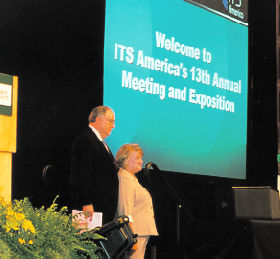 |
Dr. C. Michael Walton, professor of civil engineering, University of
Texas-Austin, and Lt. Gov./Commissioner Carol Molnau welcome attendees
to the ITS America 13th Annual Meeting. Walton is also chairman of ITS
America. Photo by David Gonzalez
|
More than 2,500 people converged on Minneapolis May 19-22 to learn about the
most current applications of intelligent transportation system technology at
the ITS America 2003 conference.
The annual conference attracted participants from China, Sweden, Norway, Finland,
Canada and Japan—a first for an ITS conference held in the United States.
ITS Minnesota hosted the Intelligent Transportation Society of America-sponsored
conference.
The conference and exhibition enabled participants to meet with hundreds of
exhibitors, participate in workshops and join site tours to explore ITS applications
in Minnesota, including the new Regional Traffic Management Center in Roseville,
the Hiawatha light rail corridor and Metro Transit’s control center.
Workshop sessions offered topics such as deployment of the 511 Traveler Information
System and use of ITS to improve intermodal freight mobility, simplify ramp
metering systems and integrate weather information systems into traffic management
systems.
Conference participants also heard national leaders in ITS technology and management
discuss topics such as using ITS solutions to help transportation and public
safety agencies work more closely together and creating national transportation
system information network to improve service and security for transportation
system users.
Lt. Gov./Commissioner Carol Molnau welcomed the conference to Minnesota, as
did Mayor R. T. Rybak of Minneapolis and Mayor Randy Kelly of St. Paul. Gov.
Tim Pawlenty also proclaimed May 19 as "Intelligent Transportation Systems
Day in Minnesota."
Volunteers from the Minnesota Chapter of ITS America staffed the registration
desks, pressroom and the Minnesota Guidestar exhibit. Marthand Nookala, division
director, Traffic, Safety and Technology, said the conference focused on practical
applications of ITS technology and ways it can be used in the future.
"The meeting demonstrated a host of ITS best practices and created a roadmap
for practitioners to follow in the areas of operations, management and emerging
technologies," Nookala said.
Representatives from the North Dakota DOT found the conference a valuable source
of information and support because they plan to start operation of a transportation
operations communications center in Fargo that will serve the Fargo-Moorhead
metropolitan area.
"We’re in the infancy of using ITS technology, but it’s been helpful meeting
with vendors to find ways to integrate the surveillance cameras, automated sprayers
and variable message signs that we are currently using," said Lyle Landstrom,
traffic operations engineer with ND/DOT’s Fargo District.
Landstrom said he and his colleagues were investigating software, fiber optic
cable and other methods to link ITS applications such as surveillance cameras
on the I-94/I-29 interchange at Fargo and an automated anti-icing sprayer on
I-29 near Hillsboro.
Gary Feist, maintenance coordinator at Bismarck, said his delegation received
valuable information and support from the Mn/DOT people they met in various
conference workshops and in informal settings.
"The Mn/DOT people were very good about sharing information," said
Feist, who planned to visit the new Regional Transportation Management Center
at the Waters Edge Building in Roseville along with other ND/DOT staff.
"We found vendors who can help us link our system’s components, meet NTCIP
(National Transportation Communications for ITS Protocol) standards and get
our TOCC operating," Landstrom added. "We sponged up a lot of information;
it was an excellent conference."
By Sonia Pitt and Craig Wilkins
|
back

|
 |
Engineers, planners learn ways to design safer pedestrian facilities |
 |
 |
Although roads and bridges usually invoke images of cars and trucks, they also
attract numerous pedestrians—a fact not lost on the 90 engineers and planners
from Mn/DOT, cities, counties and consulting firms who recently attended one-day
sessions on "Design and Safety of Pedestrian Facilities."
Michael Ronkin, Oregon DOT's bicycle and pedestrian program manager, and Charlie
Zegeer, associate director of the University of North Carolina's Highway Safety
Research Center, conducted the sessions, which were held May 19-21 in Mankato,
Brainerd and Minneapolis.
Pedestrian facilities cover physical improvements to the pedestrian environment
including traffic control devices, curb ramps, overpasses and underpasses, crosswalks,
sidewalks and other technologies, according to Kristie Billiar, Mn/DOT's pedestrian
coordinator. Cities and counties have more pedestrian facilities; state roads
present more crossing issues, she said.
In 2001, Mn/DOT formally adopted the Design and Safety of Pedestrian Facilities
report from the Institute of Transportation Engineers as the standard for integrating
pedestrian facilities into road design. The ITE report formalizes design standards
for pedestrian facilities.
"It is 'a should' rather than 'a shall' document," Billiar said.
"The guidelines don't provide all the answers. Designer creativity and foresight
are also needed," said Lisa Bigham, District 7 planning director and a workshop
attendee.
"One size doesn't fit all," she said, pointing out that pedestrian facilities
may increase in importance with an aging population. "We are designing for the
future."
According to statistics from the Department of Public Safety, 1,175 crashes
involving pedestrians occurred in Minnesota in 2001—including 46 pedestrians
who were killed and 1,184 who were injured. This represents a six percent decrease
from the previous year. People younger than 25 years old account for 40 percent
of the injuries and fatalities. Eighty-two percent of pedestrian crashes occur
in urban areas; 28 percent are on rural roads.
For more information, visit the following sites:
By Sue Stein
|
back

|
 |
Mn/DOT sells jet passenger aircraft to trim operating expenses |
 |
 |
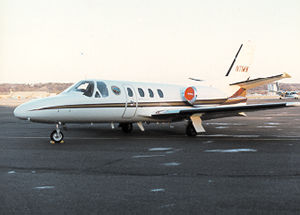 |
The Cessna Citation jet aircraft Mn/DOT purchased in 1996 was sold
for $627,500 on May 23. Staff photo
|
The Cessna Citation jet aircraft Mn/DOT purchased in 1996 was sold for $627,500
on May 23. Mn/DOT purchased the airplane for $2,000 and then refurbished it
for use by the governor, state officials and state employees. Refurbishing the
twin-engine jet cost $581,000.
The aircraft was purchased through the federal government’s surplus property
program.
Sale of the Citation will reduce operating costs of the existing Mn/DOT fleet
as well as contribute monies to the state’s General Fund.
The Citation was based at the Downtown St. Paul Airport along with the department’s
other aircraft.
Mn/DOT’s aircraft fleet retains its two twin-turboprop Beechcraft King Air
passenger planes to provide air transport service.
"Having its own air transport service gives Mn/DOT advantages in flexibility,
security, safety and cost-effectiveness when compared with using charter flights,"
said Dan McDowell, senior aviation planner.
|
back

|
 |
|
 |



